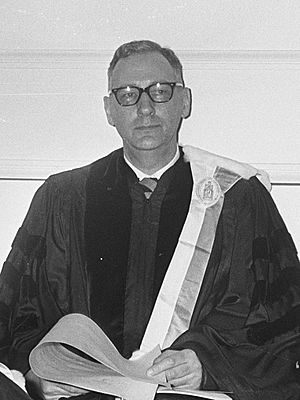Tjalling Koopmans facts for kids
Quick facts for kids
Tjalling C. Koopmans
|
|
|---|---|
 |
|
| Born | August 28, 1910 's-Graveland, Netherlands
|
| Died | February 26, 1985 (aged 74) |
| Nationality | Dutch, American |
| Alma mater | University of Utrecht University of Leiden |
| Known for | Ramsey–Cass–Koopmans model Koopmans' theorem |
| Awards | Nobel Memorial Prize in Economic Sciences (1975) |
| Scientific career | |
| Fields | Economics, Physics |
| Doctoral advisor | Hans Kramers Jan Tinbergen |
| Doctoral students | Carl Christ Stanley Reiter Rolf Mantel Guillermo Calvo |
Tjalling Charles Koopmans (born August 28, 1910 – died February 26, 1985) was a smart Dutch-American scientist. He was both a mathematician and an economist. In 1975, he won the Nobel Memorial Prize in Economic Sciences along with Leonid Kantorovich. They won for their important work on how to use resources in the best possible way. Koopmans helped us understand how to make choices that are most efficient and fair.
Contents
Life Story
Tjalling Koopmans was born in a place called 's-Graveland in the Netherlands. When he was 17, he started studying mathematics at Utrecht University. After three years, in 1930, he decided to focus on theoretical physics.
In 1933, he met Jan Tinbergen, who later also won the Nobel Prize in Economics. Koopmans then moved to Amsterdam to learn about mathematical economics from Tinbergen. He also explored other areas like econometrics (using math and statistics to study economic data) and statistics. In 1936, he earned his PhD from Leiden University. His main teacher was Hendrik Kramers.
Moving to the United States
Koopmans moved to the United States in 1940. He first worked for the government in Washington D.C.. There, he studied how to find the best routes for transportation. Later, he moved to Chicago and joined a research group called the Cowles Commission for Research in Economics. This group was connected to the University of Chicago.
In 1946, Koopmans became a citizen of the United States. In 1948, he became the director of the Cowles Commission. He was also chosen as a Fellow of the American Statistical Association. In 1950, he became a member of the Royal Netherlands Academy of Arts and Sciences.
Moving the Cowles Foundation
Over time, some people at the University of Chicago didn't agree with the Cowles Commission's work. So, in 1955, Koopmans convinced the Cowles family to move their foundation. It moved to Yale University and was renamed the Cowles Foundation. He kept doing important research there. He studied how economies can grow in the best way and how different parts of production work together.
His Important Discoveries
Koopmans's early work on a theory called Hartree–Fock is linked to something famous called the Koopmans' theorem. This theorem is very well known in quantum chemistry, which is a part of physics and chemistry.
He won his Nobel Prize for his ideas on how to use resources in the best way. This included studying how inputs (like materials and labor) and outputs (like products) in a factory or business affect each other. He also looked at how this relates to how efficient an economy is and how prices are set.
His Family
Tjalling Charles Koopmans was the son of Sjoerd Koopmans and Wytske van der Zee. His middle name, Charles, likely came from his father's name, Sjoerd.
Interestingly, Tjalling Koopmans was related to another Nobel Prize winner, Simon van der Meer. They were first cousins once removed.
Tjalling also had two brothers. One of them was theologian Rev. Dr Jan Koopmans. During World War II, when the Germans occupied the Netherlands, Jan wrote a famous pamphlet. It was called "Bijna te laat" (meaning "Almost too late"). This pamphlet warned people about the dangers facing Jewish people under the Nazi government. Sadly, in 1945, near the end of the war, Jan was accidentally shot and died while watching an event in Amsterdam.
See also
- Linear programming
- Transportation theory (mathematics)
 In Spanish: Tjalling Koopmans para niños
In Spanish: Tjalling Koopmans para niños


